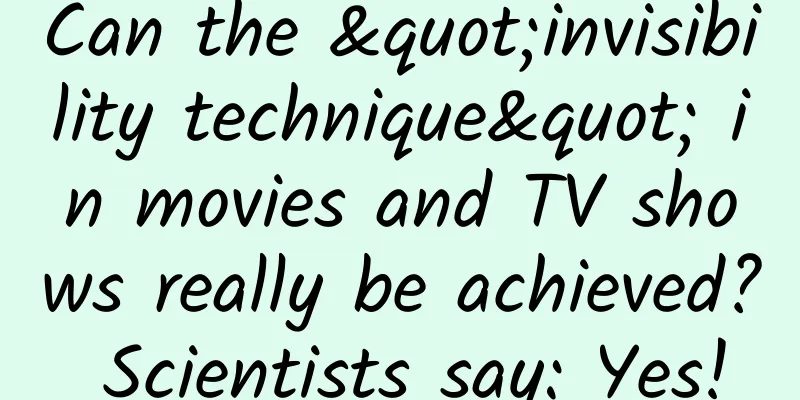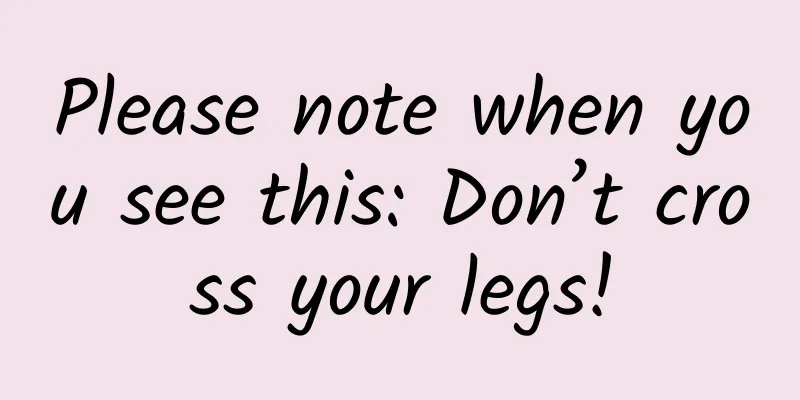Can the "invisibility technique" in movies and TV shows really be achieved? Scientists say: Yes!

|
Invisibility has always been a frequently appearing science fiction idea in various film and television works, whether it is the six children in "Calabash Brothers", the invisible woman in "Fantastic Four", or the invisibility cloak in the "Harry Potter" series of novels. The classic plot is often like this: a Doctor Strange or a mad scientist suddenly develops a special potion in the laboratory. After drinking it, the body "dissolves" and becomes as transparent as the air, but the clothes cannot become invisible, so there is a strange scene of a hat and coat floating in the air. Then the invisibility technique that makes people think Is it really technically possible? 1 Light refraction and image distortion Let's start with the refraction of light. We can see an object with our eyes because the object itself can emit light, or reflect light from light sources such as sunlight and LED lights. In either case, the light from the object eventually propagates to the human eye and is perceived . In the same uniform medium, light propagates approximately in a straight line, and the viewer will see objects at a certain distance along the horizon. But if light passes through two different media, such as water and air, the situation is no longer so simple. The speed of light in air and water is different. It is faster in air, close to 300,000 kilometers per second, and relatively slower in water, just like one is a high-speed train and the other is a green train. In Figure 1, the light from a fish in the water could have traveled straight from the water to the interface between water and air to the human eye along a straight line (ABC). However, the world of light is also "very inward-looking". It always takes the most time-saving path from the starting point to the end point, so it will choose another route (ADC). The journey of the "green train" in the water is shortened (AD<AB), and the journey of the "high-speed rail" in the air is longer (DC>BC). However, after all, the "high-speed rail" is much faster, and the total time spent is still shorter. In this way, the light is "bent", which is called refraction of light . Since the refractive index of water is greater than that of air, water is called a denser medium and air is called a sparser medium. However, viewers instinctively believe that light travels in a straight line and see the image of the fish at A' above the actual position A. Therefore, when fishermen use a harpoon to fish, they must stab it downwards from the position of the image they see. Figure 1: Refraction of light between water and air (left) and total reflection (right) Source: Light Science / Veer However, if the fish happens to be in a relatively hidden position in the water, the angle between the light from the fish and the water surface is small enough, and the light will be totally reflected like it hits a mirror, and will not be refracted into the air. This is equivalent to getting off a green train at the station and then getting on another green train instead of the high-speed train. Because the light seems to be trapped in the water, the viewer cannot see the fish at all from a certain angle. However, if it is a chopstick, the lower half is in the water and the upper half is exposed to the air. It will be bent and warped when viewed from above, and will become two misaligned pieces when viewed from the side. This is all caused by the refraction of light. Figure 2: Pencil drawing of "two misaligned sections" under light refraction Source: Light Science / Veer By using light refraction to cleverly change the direction of light, you can achieve all kinds of incredible effects, such as the following magic trick of a coin passing through a water bottle: Video 1: Magic trick of passing a coin through a water bottle The secret behind the magic can be found in another video at the end of the article. Similarly, a picture will also disappear inexplicably in water: Video 2: Pictures disappearing in water This is because the light from the image on the paper card needs to pass through multiple media such as the air in the small packaging bag, the plastic outer shell of the small packaging bag, water and outside air to reach the human eye. During this refraction process, if total reflection occurs at any of the interfaces, the image will disappear from the viewer's sight. There is also a special water tank. Use a syringe to inject or suck out water in the diagonal space of the water tank, and two different pictures can be switched to each other like "changing faces". A smiling face can turn into a crying face, and a crying face can turn into a smiling face. The red and blue masks can also change back and forth. Video 3: A water tank device that allows you to see two images switching back and forth. As shown in the figure below, the "mastermind" behind it is also the total reflection of light. Figure 3: When the diagonal space is filled with air, the viewer sees Figure B due to total reflection; when the diagonal space is filled with water, the viewer sees Figure A because light propagates in a straight line in a uniform medium. Source: drawn by the author The issue of light refraction in a painting by the Renaissance artist Leonardo da Vinci was also hotly discussed. In the painting "Salvator Mundi" by Leonardo da Vinci, Jesus the Savior holds a crystal clear ball in his hand, which seems to be "fine" on the surface. However, careful observers complain that the wrinkles on the clothes behind the transparent ball should be misaligned and distorted due to light refraction, but in the painting they appear to be intact, which is puzzling. Figure 4: Leonardo da Vinci's famous painting "Salvator Mundi" suspected of containing unreasonable light refraction effects Source: Wikipedia In this regard, optical professionals have conducted serious research, using specialized optical simulation software, including 3D modeling and ray tracing, to simulate solid and hollow spheres of various materials and thicknesses to obtain the imaging results after refraction, and compared them with the effects in the painting. They also published a paper titled "On the Optical Accuracy of "The Savior"." The final conclusion is that in order to achieve a similar effect to the painting, a hollow sphere must be used, and the refractive index of the outer wall material of the hollow sphere is 1.51714 and the thickness is 1.3 mm. For comparison, the refractive index of air is 1.0003, the refractive index of water is 1.3333, and the refractive index of glass is about 1.5, so the painting should be a hollow glass sphere. But was it possible to make such a thin glass ball hundreds of years ago? Even if it was made, it would be easy to break. How could you hold it with your hands? Of course, some people think that this kind of rigid rational analysis is meaningless. Master Leonardo da Vinci was not creating a realistic creation of an everyday person. He was painting the sacred savior Jesus. The distorted folds of clothes would show a disrespectful attitude. What's more, Leonardo da Vinci was not only a painter, but also a generalist. He had knowledge of various sciences including optics. He would not be unaware of the refraction of light, nor would he fail to observe the image distortion of a real glass ball. He probably did it on purpose, not carelessly making a low-level optical mistake. Regardless, the painting itself is priceless and was sold at Christie’s in New York in November 2017 for a whopping $450 million. 2 Optical device for creating the effect of hiding objects Returning to the main topic of this article, "Invisibility", objects that the human eye can see are often caused by incident light hitting the surface of the object, producing reflected light that enters the human eye. If the incident light is refracted in an appropriate way and changes direction, it just bypasses the space occupied by the object. The viewer will feel that the light is passing through the empty space and directly reaches the human eye, forming a visual invisibility effect. This has been proven to be theoretically feasible in optics. Figure 5: Invisibility is achieved by bending light around an object to be hidden: To the viewer on the right, there is no difference in the visual effect between the light bending around the object (left) and passing directly through empty space (right). “If you want to do your work well, you must first sharpen your tools.” In order to truly achieve this effect in the experiment, it is necessary to resort to various optical devices. The lenses in magnifying glasses, myopic glasses, telescopes, and microscopes are all called lenses. They look like small round lenses on the surface, but they are very powerful. By utilizing the light refraction phenomenon caused by the different refractive indices of air and glass, they can control the convergence and divergence of light, and can also enlarge and reduce images and bring them closer or further away. In the following optical system composed of four different lenses, the placement of the lens is properly designed to create a visual blind spot for viewers in front of the fourth lens, who can see the background objects behind the first lens but cannot see the objects in the blind spot. When several fingers are inserted into the visual blind spot between the lenses, the viewer will not see the fingers, but only the background grid. Figure 6: A stealth system composed of four lenses with a visual blind spot (orange area) [5] Figure 7: The viewing effect of the four-lens stealth system [5] It should be said that this is only a kind of invisibility within the lens's field of view. If you look outside the lens, everything is exposed to your eyes, although the lens can be made larger. Not only that, but the viewer must look directly at the lens. If you look at it sideways, it is easy to be exposed. Lenses are not only circular, but also cylindrical. Unlike circular lenses, which can bend every light from all directions, cylindrical lenses see objects as composed of lines parallel to them and can refract the entire line in a certain direction. If many tiny cylindrical lenses are arranged in an array, they become a cylindrical microlens grating. The cylindrical microlens grating is also a "master" of controlling the direction of light. For example, many people have seen the "double picture". A special card looks like the first photo when viewed from one direction, and a completely different photo when viewed from another direction. This is because the surface of the card is covered with a layer of cylindrical microlens grating. Originally, the card was printed with a complex containing two pictures. The red vertical stripes and green vertical stripes decomposed into them can be projected in two different directions by the grating, each synthesizing into a different photo. If these two directions happen to correspond to the left and right eyes of a person, the pictures corresponding to the perspectives of the left and right eyes are projected respectively, and naked-eye stereoscopic display can be achieved without wearing glasses. Figure 8: A cylindrical microlens grating that can refract light to the left and right eyes in two different directions. Image source: Wikipedia In addition to double-image and naked-eye stereoscopic display, cylindrical microlens gratings can also show off their invisibility skills, which stems from their "discrimination" against "fat" and "thin" people. For an object in a parallel direction behind the grating, if it is "thin", the light will be easily refracted out of the viewer's field of view and hidden, while if it is "fat and generous", a large amount of light will enter the viewer's field of view and appear to have not disappeared. Figure 9: The light refraction effect of cylindrical microlens grating on objects of different widths Source: Drawn by the author The thin chopstick below mysteriously disappears, but the horizontal stripes behind it are intact (because it is actually very wide when viewed vertically). Of course, the orientation of the grating must be correct, and the chopstick must be nearly parallel to the direction of each columnar microlens. Video 4: Chopsticks disappearing under the cylindrical microlens grating In a popular video on the Internet, optical expert Academician Chu Junhao demonstrated at a party that his legs "disappeared" under the cover of a magical material, but the horizontal lines of the stage background behind him could still be clearly seen. The cylindrical microlens grating used was also this kind of cloaking method. The defects of this stealth method are also obvious. There are strict requirements for the shape of the object to be hidden, whether it is standing or lying. As long as it "does not meet the standards", it will be "exposed". The cylindrical microlens grating is destined to be used only in specific stealth scenarios. Academician Chu Junhao performs invisibility trick. Image source: Bilibili The following optical stealth device is even larger: in a large pool, a special hexagonal prism-shaped water tank is placed. Only the "cave" in the center of the tank is filled with water. Many other parts are hollow and contain only air. A part with a hexagonal star-shaped cross-section (dark blue in the picture below) is solid and made of glass. In this way, the incident light on one side has to be refracted between the three media of water, air and glass. Due to the special geometric shape of the water tank, it is equivalent to bypassing the cylindrical water cavity in the center, and the viewer on the other side feels that this part has disappeared. If a fish in the water swims into the hole of the water cavity, it will disappear without a trace, and the viewer will only see the transparent pool water and green water plants behind the water tank. Figure 10: A hexagonal optical device that can hide fish in a pool of water[7] Similar "hexagonal castles" do not have to be built underwater, they can also be placed on a table for viewing. It can be found that the metal weights originally surrounded by the glass prism are gone, but the car model behind them can still be clearly seen. Figure 11: Hexagonal prism optical cloaking device [4] 3 Negative refractive index materials and the realization of true invisibility Although the above-mentioned optical stealth devices can provide a certain degree of object disappearance effect, they are still quite different from the real invisibility cloak that everyone expects. The concept of negative refractive index materials that has emerged in recent years has ignited new hope for invisibility. The refractive index of natural materials is generally greater than 1. If the refractive index of water is negative, you will see the image of fish in the water floating in the air above the water. Compared with this mirage effect, more importantly, this material is an ideal choice to wrap the hidden object in it like clothes, realizing the above-mentioned idea of bending light and bypassing invisible objects. Since there is no such material in nature, researchers have turned their attention to the use of nanotechnology to synthesize it artificially. The world-famous British Museum displays a magical glass goblet artwork called the Luchiggs Cup, which was made by the ancient Romans 1,600 years ago. The peculiarity of this artwork is that when the light shines from the front, the cup appears green, and when it shines from the back, the cup appears red. Researchers have found that this "chameleon" effect is due to the dissolution of gold and silver metal particles in the glass, with a particle diameter of only about 50 nanometers. Although the ancients at that time did not understand what nanomaterials were, they had inadvertently dabbled in this technology through repeated practical attempts. Similarly, in many parts of the world, the technology of doping nanoparticles in glass is also used in the colorful painted patterns on the windows of some historic cathedrals. Today, in the 21st century, researchers can manipulate various types of nanoparticles more freely and flexibly, just like playing Tetris or building blocks, placing them in different positions and arranging them into different structures to produce all kinds of wonderful material properties. It has also become possible to artificially synthesize new materials with negative refractive index. In a paper published in Science magazine in 2015, researchers used fluorides of metals such as silver and magnesium to form a mesh material, and then interspersed nanosilver wires generated from porous alumina into it. The resulting negative refractive index material sheet can, as expected, hide the wrapped object like a cloak, bringing the dream of a negative refractive index material invisibility cloak one step closer. Figure 12: Effect of negative refractive index nanomaterial invisibility cloak: with invisibility cloak (left) and without invisibility cloak (right) Judging from the results shown in the paper, this invisibility cloak is not in vain. However, the current results are still observed under a microscope. The size of the invisibility cloak is only at the micron level, thinner than a hair, and requires strict experimental conditions. It cannot be used in daily life in the short term. So is there any way to achieve invisibility optically? On the one hand, it is not difficult to create an optical trap device , place an object in the visual blind spot, and make the object disappear from sight through "smoke and mirrors". Moreover, "all roads lead to Rome", and various common devices in the laboratory can be used as tools; On the other hand, the true invisibility cloak imagined in science fiction, although theoretically feasible, is not easy to actually process and manufacture. Negative refractive index materials have brought new hope to researchers, but it will be difficult for them to appear in practical applications for the time being . Video 5: The secret of the coin passing through the water bottle magic: the coin is always in the bottle, but if it happens to be in the blind spot on either side, it will not be seen due to light refraction. References [1] A. Cho, High-Tech Materials Could Render Objects Invisible, Science 312, 1120-1120 (2006) [2] M. Liang, MT Goodrich, and S. Zhao, On the Optical Accuracy of the Salvator Mundi, arXiv:1912.03416 (2019) [3] JB Pendry, D. Schurig, and DR Smith, Controlling Electromagnetic Fields, Science 312, 1780-1782 (2006) [4] K.-T. Lee, C. Ji, H. Lizuka, and D. Banerjee; Optical cloaking and invisibility: From fiction toward a technological reality, J. Appl. Phys. 129 (23), 231101 (2021). [5] JS Choi and John C. Howell, Paraxial ray optics cloaking, Opt. Express 22(24), 29465-29478 (2014) [6] Su Yibo, Wang Shuan, Cao Feng, Chen Shumei, Deng Bochang, Exploration of the invisibility phenomenon of objects using cylindrical lens arrays, Physical Experiment 43(9), 22-28 (2023) [7] H. Chen, B. Zheng, L. Shen, H. Wang, X. Zhang, NI Zheludev and B. Zhang, Ray-optics cloaking devices for large objects in incoherent natural light, Nat Commun 4, 2652 (2013). [8] X. Ni, ZJ Wong, M. Mrejen, Y. Wang and X. Zhang, An ultrathin invisibility skin cloak for visible light, Science 349, 1310-1314 (2015) Planning and production Source: Light Science Forum/Chinese Optics (id: ChineseOptics) Review丨Zhang Jie, Chief Engineer of China Textile Construction Planning Institute Planning丨Fu Sijia Editor: Fu Sijia Proofread by Xu Lai and Lin Lin |
>>: Do cats really have nine lives? Don't get me wrong, they are just tough.
Recommend
Qianwanshe's new short video money-making project: Douyin emoji package leads to 20,000 yuan a month
Moreover, I didn’t invest a penny. Since the emot...
8 tips for selling products through live streaming!
1. Four elements of product marketing In the prod...
Apple Watch UI Animation Analysis
After watching the keynote of Apple Watch, we wer...
Tips for writing titles for new media operations!
One of the basic skills of new media operation is...
Shenyang Mini Program Production Company, how much does it cost to produce an educational mini program?
How much is the quote for educational production ...
Paid Q&A is on the decline: content is scarce and big IPs bring in significant but unstable traffic
As one of the earliest users of Zhihu Live, Zhao ...
How should educational companies acquire customers on Kuaishou?
2019 was a "winter period" for the educ...
Analysis of offline event operation cases!
With the spread of the 996 and long-week corporat...
Baidu bidding creative writing, how to write a good creative idea?
A good creative can not only improve the ranking ...
Why do Android fans choose iPhone 6s instead of Nexus 6P?
Antonio Villas Boas is a technology journalist. A ...
Stock Market Ferryman "90-Day Special Training Camp for Professional Traders' Top Secret Course"
Stock Market Ferryman "Professional Trader T...
Celebrities reveal they have stomach cancer! These 5 types of people are particularly at risk, but one method can help prevent it!
Recently, a video in which Yu Donglai, chairman o...
Which keyboard is better? MacBook Pro vs. Razer Blade
Razer updated its gaming notebook series this yea...
Attack, defense, and speed are all bad. How did the koala survive?
Koalas, also known as koala bears, are cute mamma...
Is there a scientific basis for the saying that shopping makes people happy?!
As soon as Double Eleven arrives, we all become s...





![Improve conversion rate: How to make App [preview video]?](/upload/images/67cc11790d9fe.webp)



